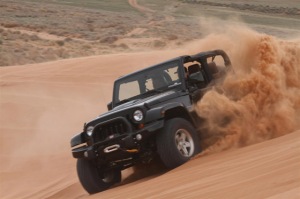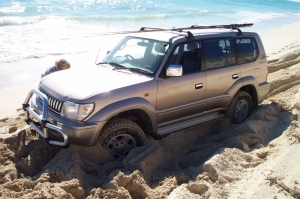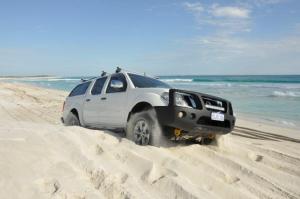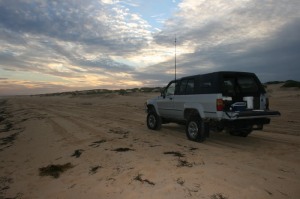Outback Kev Here,
Over the many years of me travelling around Australia, I have helped many other road users out of some sticky situations – even sandy situations. The best advice that I could recommend anyone, is preventative action! Get educated on where you are going and what you will need before taking off on a road trip or off the beaten track at all times.
The HINTS & TIPS outlined below are applicable to driving in any sand, be it on the beach, in sand dunes, in the desert or in the forest. Anywhere you come across soft sand, these techniques will be applicable. In particular, it is worth mentioning again, that you should NEVER drive across a steep hill, especially sand dunes. Doing so can have disastrous consequences. There is a serious and very real risk of rolling your vehicle all the way down to the bottom of the hill.
There are two elements to driving your four wheel drive on soft sand. These are:
- Tyre Pressure
- Momentum
Applying these elements do your driving technique will result in your vehicle ‘floating’ on the sand, decreasing your chances of becoming bogged. Naturally there is no guarantee that you won’t bury yourself to the axles, but your chance of success is increased if you pay attention to these elements.
REDUCE YOUR TYRE PRESSURE:
Reducing your tyre pressure will spread the weight of your vehicle across a greater surface area, and increases the surface area of the tyre in contact with the ground and achieves two objectives: 1. Increases traction 2. Prevents the tyres from sinking into the sand quite as much.
There are many schools of thought on how much you should reduce your tyre pressure when driving on soft sand, but a guide would be to reduce your tyre pressure to half that of your normal road driving. If you find your engine struggling then reduce tyre pressure some more. You can try reducing in 4psi increments until you’re satisfied. Finding the right pressure for your vehicle and the current conditions can be a lot of trial and error.
MOMENTUM:

Use low range initially. If you start to get bogged, low range will provide you with the power you need to drive out, but will also allow you adequate speed to keep you on top of the sand. If you decide that the beach is hard enough then you can change to high range. CAUTION: Do not overdo your speed. Driving on sand is nothing like driving on the road and driving quickly greatly increases the chance of serious accident.

When you do get bogged in soft sand there are a number of techniques to getting back out.
- Firstly, it’s important to realise early that you are bogged. There is no point in spinning your wheels. This just digs you in further and makes any recovery effort more difficult.
- Don’t panic! The vast majority of the time, if your car stays bogged for a while then the only consequence is that you’re late to your campsite. So stay calm and take your time to think it though.
- Reduce your tyre pressure even more than you already have. Remember that the more you reduce your tyre pressure the more your vehicle will ‘float’ on the sand.
- Try to reverse out. Often the tracks you used to drive in are solid enough for you to drive out on. Then you can have another go or take a different route.
- Slowly drive backwards and forwards over the same track. This compacts the sand and hopefully allows you to drive out.
- If these tips don’t get you out then get your shovel out and start digging. Choose which direction you want to drive out and then dig out the sand in that direction. Don’t forget that you’ll need to clear the sand from underneath your axles and differentials as well. And if you’re bogged enough then you’ll also need to clear the sand away from your undercarriage as well.
- Make a track for your wheels. You could try lining the track with dry seaweed (wet seaweed can be slippery), sticks, leaves etc. Anything to gain some traction.
- Also, try something like Max Tracks. Static methods of recovery and those that don’t use other vehicles are much safer.
- If these fail then get out your snatch strap if you have a travelling companion. Keep in mind that you don’t need to tear the car in half in order to pull someone out of the sand. Often a gentle ‘tow’ is enough.
- Still bogged? Do you have a winch? If not then don’t give up, just do it all over again, but try harder.

Be aware of steep drop-offs on beaches. These are caused by wave action eroding the beach sand and forming small cliffs. Driving too close to the edge will cause these cut-aways to collapse, resulting in your vehicle rolling and probably becoming very wet.
Bright sunshine will make features on the beach harder to see. With the glare off the white sand in your eyes, it’s very easy to not see holes, cut-aways, erosion etc. Driving your vehicle into a sand hole can bring your day to a very sudden and complete stop.
Don’t get caught too close to the water. If you do a quick google search you’ll find any number of photos of 4WD vehicles being destroyed by pounding surf. Or buried to the roof after a high tide, it is actually more common that you think!
Don’t turn sharply. With reduced tyre pressure, turning sharply will increase the chances of your tyre separating from the bead of your rim. Tyres that separate from the bead deflate very rapidly.
Not getting bogged is much easier than digging yourself out of a bog!
ITEMS TO TAKE WITH YOU – IN CASE OF GETTING BOGGED – BE PREPARED!:
- Long handled shovel
- Snatch Straps
- 4WD acceptable recovery points (factory tow points are often not strong enough).
- Shackles to connect your snatch straps to your recovery points.
- A tree protector or bridle. This can be used to disburse the load across multiple recovery points.
- MaxTrax or equivalent.
- A sand flag so that people can more easily spot you from over the top of a sand dune.
- Tyre deflator to let your tyres down before you hit the sand
- Compressor to re-inflate your tyres
Outback Kev signing off until next time!



